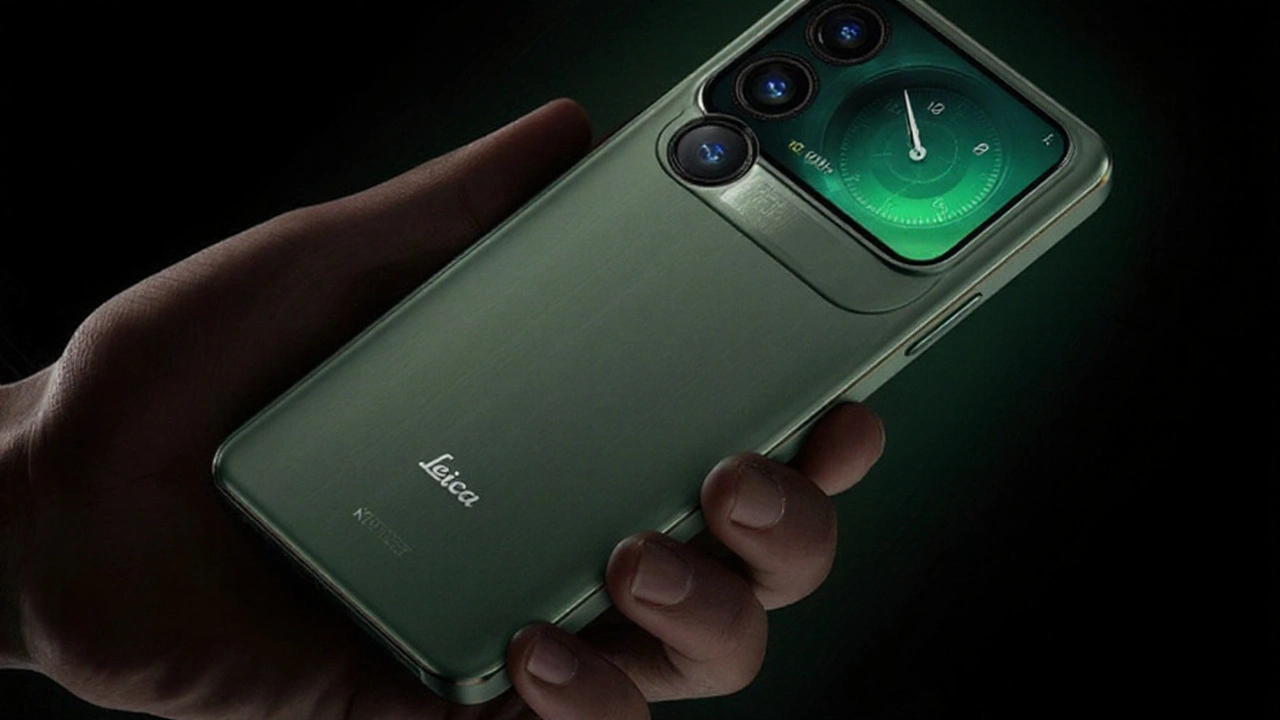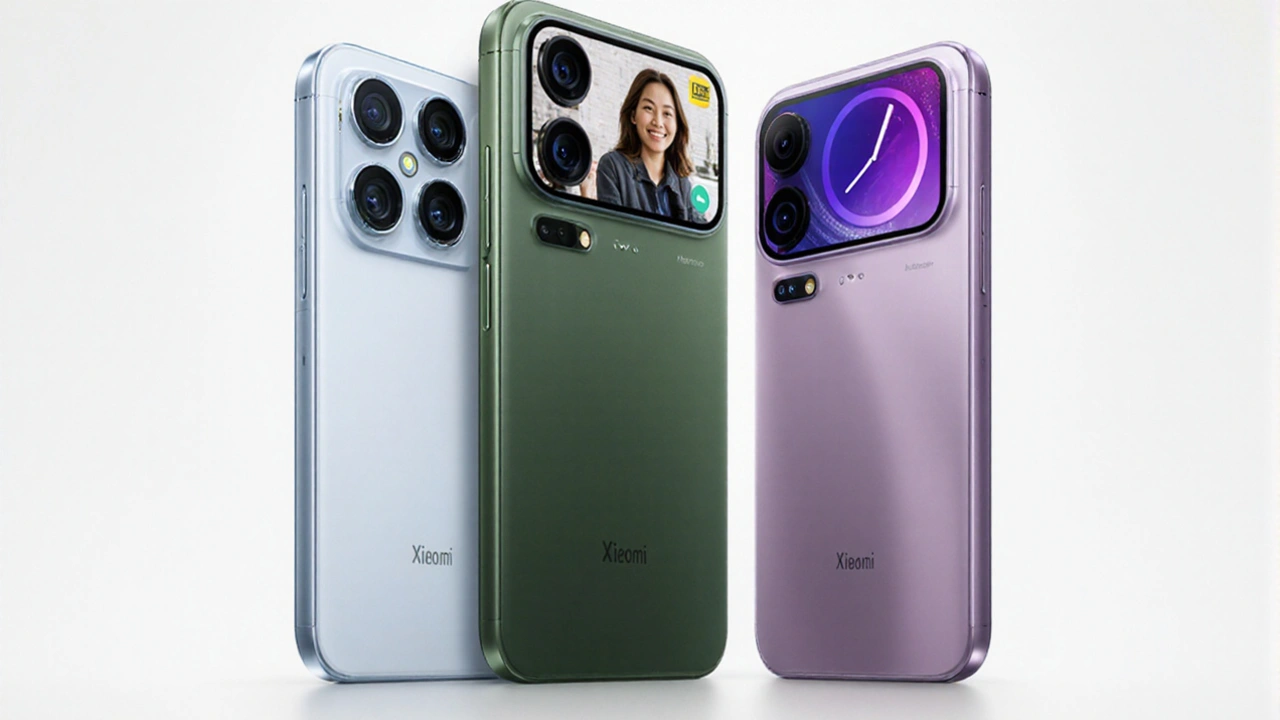
What makes the Xiaomi 17 series a real game‑changer?
When Xiaomi announced the 17 lineup, most tech fans expected another incremental upgrade. Instead, the company unveiled a phone that literally turns its back into a screen. The 6.9‑inch rear screen smartphone on the Pro Max measures 3.4 inches, making it the biggest rear display ever fitted inside a unibody handset. This isn’t a novelty gimmick; Xiaomi has built software that lets the back panel act as a live viewfinder, a gaming controller and even a translation board.
Under the hood the Pro Max runs on Qualcomm’s Snapdragon 8 Elite Gen 5, a 3 nm processor that promises flagship‑level speed while staying power‑efficient. Pair that with a 6.9‑inch flat LTPO AMOLED panel that can hit 120 Hz and a jaw‑dropping 3 500 nits peak brightness, and you’ve got a front screen that stays crisp even under bright noon sun.
The battery is another headline act. At 7 500 mAh the Pro Max dwarfs typical flagship cells that sit around 4 500–5 000 mAh. Xiaomi backs the massive pack with 100‑W wired and 50‑W wireless charging, which means you can go from zero to ninety‑nine percent in under an hour.
- Display: 6.9‑inch LTPO AMOLED, 120 Hz, 3 500 nits
- Rear screen: 3.4‑inch touchscreen, dual‑purpose UI
- Processor: Snapdragon 8 Elite Gen 5 (3 nm)
- Battery: 7 500 mAh, 100 W wired / 50 W wireless
- Camera: Triple 50 MP Leica setup + 5x periscope telephoto
- OS: Android 16 with Xiaomi HyperOS, dual‑screen optimised

Why the rear display matters for everyday use
Gamers get an immediate win. Xiaomi ships a dedicated case that hooks up the back screen as an extra control pad, letting you keep the main display free for gameplay while the rear shows stats, maps or additional buttons. The same hardware also benefits content creators. Streamers can pop up live comments on the back panel, vloggers get a real‑time preview of their front‑camera footage, and photographers can frame selfies using the primary camera’s viewfinder on the rear screen—no more awkward guess‑work.
Travelers will love the face‑to‑face translation feature. Speak in your language, and the rear screen instantly shows the translated text for the person you’re talking to, turning a phone into a pocket interpreter. The dual‑screen approach also means you can keep a video call on the front while scrolling notes or a presentation on the back, boosting productivity without juggling apps.
All these scenarios hinge on Xiaomi’s HyperOS, which the company says is built from the ground up for dual‑screen workflows. Unlike previous attempts where apps simply duplicated their UI, HyperOS lets developers create truly separate experiences for each screen, reducing lag and avoiding the clunky switch‑overs that annoyed users in past dual‑screen phones.
In short, the Xiaomi 17 Pro Max isn’t just adding a flashy extra monitor; it’s rethinking how a phone can be used in real life. Whether you’re gaming, shooting video, traveling abroad or just trying to make a long battery last, the combination of a massive battery, a bright primary display and a functional rear screen offers a compelling alternative to the single‑screen flagships that dominate the market.
Comments (6)
-
Michelle Roque September 27, 2025
Wld this even work in real life?
-
Joshua Rainey October 12, 2025
Oh sure, because we all need a phone that doubles as a fridge door, right?
-
Gail Robb October 28, 2025
Let us not be blinded by the glossy marketing veneer and consider the underlying philosophical ramifications of a device that attempts to be both canvas and brush, tool and muse. The rear screen is not merely an appendage; it is an assertion of a new ontology where the phone is no longer a singular object but a bifurcated experience. This duality forces us to confront the age‑old dichotomy of form versus function, now compounded by the temptation to subsume one into the other. If we accept this, we are implicitly endorsing a future where the boundaries of personal interface dissolve into a seamless continuum of interaction. Yet, such a progression may erode the very notion of privacy, as the back of the phone becomes a public billboard for our notifications and activities. Moreover, the massive 7,500 mAh battery, while impressive, raises concerns about resource consumption and environmental impact. A battery of that magnitude demands more raw materials, more mining, more waste, and ultimately a larger carbon footprint. The Snapdragon 8 Elite Gen 5 promises power, but power without restraint can become a vice. The rear screen’s potential for gaming controllers or translation boards sounds innovative, but it also encourages a fragmented attention span, a constant juggling of realities. In the grand scheme, we must ask whether this convergence of capabilities enriches human experience or merely amplifies our addiction to screens. The HyperOS claims to manage dual‑screen workflows, yet software is only as good as the intentions of its developers. If they merely mirror existing UI paradigms, the novelty will be superficial. Conversely, if they truly reimagine interaction, perhaps there is merit. But merit must be weighed against the cost of complexity, both in hardware and in user adaptation. Ultimately, the Xiaomi 17 Pro Max is a bold experiment-one that invites us to rethink the phone’s role, but also reminds us to stay vigilant about the unintended consequences of such technological leaps.
-
Pradeep Chabdal November 12, 2025
The prose is commendable, yet one must question whether the aesthetic polish merely masks a superficial gimmick rather than a substantive evolution.
-
andy heri November 28, 2025
Honestly, if you’re a gamer or a creator, the extra screen could actually streamline your workflow and keep the main display free for what matters most. It’s a clever way to multitask without the usual clunkiness.
-
Jeremy Perlman December 13, 2025
Exactly! The rear display isn’t just a novelty-it’s a functional extension that can boost productivity, especially with HyperOS optimizing split‑screen apps.
